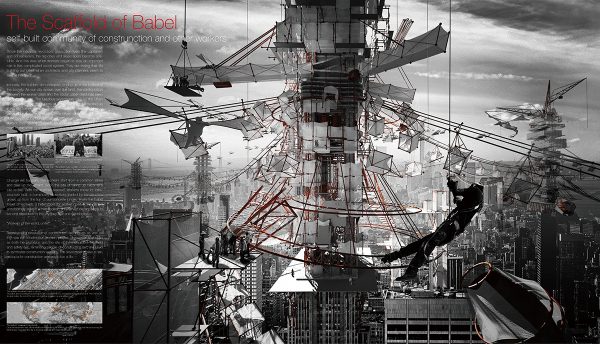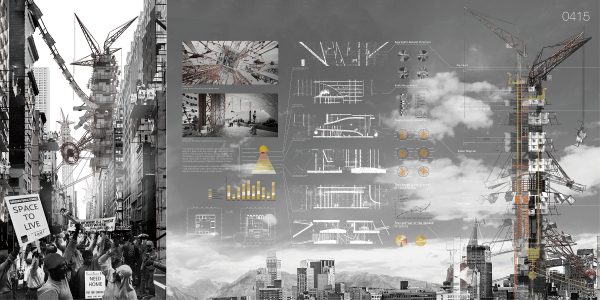Honorable Mention
2017 Skyscraper Competition
Yutan Sun, Tongda Xu, Luojia Zhang, Dinglu Wang, Tianjun Wang
China

Since the industrial revolution, production fuels the capitalism and consumerism, the big cities and skyscrapers become possible. And this was when workers began to play an important role in this complicated social system. Due to the height they need to work at, construction workers are viewed as one of the most dangerous professions now, not to mention in early days when security measures were less efficient. They are risking their life building our cities when architects and city planners seem to take all the credit.
Ironically, the construction builders are underpaid, surviving at the bottom of the society. As our cities sprawl over the land, the confrontation between the worker class and upper social classes has become sharper than ever. The luxurious skyscrapers take up the urban space, while the constructers of these buildings end up in city corners or even homeless. They have laid every piece of brick in the city, yet were driven away from the kingdom they built by high prices and other urban problems. Seldom do they have a chance to live a city life.
“Workers of the world, unite!”
Change will happen. The workers start from a common strike and take up movement. Soon the site of taking up will become a site to live. With scaffolds erected, workers move in, infrastructure built, a community of workers leaded by constructors grows out of the top of our concrete jungle. That’s the babel tower of workers, a heterotopia for worker class in the central and topmost area in a metropolitan, a deserved decent place to live and reproduce in the city they have devoted themselves to.
Method & Structure
Representing revolution of construction techniques as well as the new roll construction workers played, skyscraper is chosen as both the prototype and the site of the monument. Scaffold and safety net, reminding people of constructing set, are used to symbolize their identity. These skyscrapers are placed on top of pre-existing skyscrapers, which allow construction workers to create their own society in city center. Considering construction progress, the monument consists of 6 layers from the bottom up:
1. Defense. Guarded by soldiers, this is the first step of uprising, ensuring safety of the upcoming new society.
2. Equipment. Taking energy crisis and environmental pollution into consideration, we created space for large machineries to purify water and air and to converse solar power, producing clean energy for the society.
3. Transportation. Several towers would be built in a city successively to meet the need and cable cars would act as public transport among them.
4. Residence & Agriculture. After infrastructure is well-developed, housing would be built for workers moving in. Every resident is provided with a piece of farmland. Confronted with food shortage, residents can grow their own food.
5. Communication. Open space would be built on top of high-density residence for communication. It’s also place for all kinds of outdoor activities.
6. Construction. Construction process can be continued whenever is needed. On top of the tower, this layer is also for sightseeing.
These skyscrapers will allow construction builders to live a self-sufficient life in the center of the metropolitan and exist as a memorial of a group of hard workers.


This work is licensed under a Creative Commons License permitting non-commercial sharing with attribution. https://creativecommons.org/licenses/by-nc-nd/4.0/



